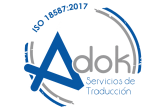Revised machine translations
When talking about revised machine translations, we should first clarify what we mean by a machine translation per se. By a machine translation, we are referring to the translation of one or more texts that is done automatically and instantly by software on a computer or other device, without the intervention or revision of a human translator.
In this sense, and because they are not revised, machine translations are often not of the highest quality and may contain errors and/or ambiguities in the target language, which can lead to an inaccurate translation. This is where the need arises for a qualified physical translator to carry out a revision of the translation in question and its content, and to ensure that the translation is accurate and has proper grammar and style, and that it contains and communicates the meaning of the original text at all times.
A revised machine translation thus involves proofreading and making corrections to the translation generated by a machine translation model to ensure accuracy and fluency. This usually includes correcting translation errors, adjusting the tone and style to be appropriate for the specific context the translation deals with, and ensuring that the appropriate language is used for the intended audience. This task is carried out by a specialised human translator, who carries out a thorough revision of the translation to achieve the best possible result.
In what cases and for what types of documents is a revised machine translation necessary?
In general, a revised machine translation is necessary in cases where the accuracy and consistency of the translation are critical and where there can be no margin for errors. It is also common in situations where a large volume of documents is to be translated and given the sheer size of the translation, it is preferable to use a software tool that performs the translation automatically in the first place, so that it then gets to the hands of a human translator that proofreads and corrects it.
Revised automatic translations are usually very useful and are used especially in professional settings where the highest quality in translations is required and that these are correct, appropriate and do not contain any type of errors that could affect the information provided and lead to communication and understanding issues for the recipient of the translation. This high level of quality is required in sectors such as medicine, science, finance, technology, etc., as well as in the legal and juridical environment or when presenting documents to authorities and public administration bodies.
Some of the documents for which a machine translation always requires to be revised are the following:
![]() Legal or administrative documents, such as contracts, wills, judgments, etc.
Legal or administrative documents, such as contracts, wills, judgments, etc.
![]() Financial documents, g. balance sheets, annual reports, company or site procedures, manuals, etc.
Financial documents, g. balance sheets, annual reports, company or site procedures, manuals, etc.
![]() Medical documents, such as medical records, treatment protocols, certificates of medical results, e.g. Covid-19 tests such as PCR, etc.
Medical documents, such as medical records, treatment protocols, certificates of medical results, e.g. Covid-19 tests such as PCR, etc.
![]() Technical and scientific documents, such as scientific articles, user manuals, industrial documents, patents, etc.
Technical and scientific documents, such as scientific articles, user manuals, industrial documents, patents, etc.
What is the difference between a proofread machine translation and a full machine translation by a translator and what advantages does it have over the latter?
While a revised machine translation is first generated by a machine translation software and then proofread and corrected by a qualified human translator, in the case of the more traditional translations, this would be one produced entirely by the translator without the assistance or intervention of any machine translation tool.
Undoubtedly, the main advantage of using a revised machine translation, especially in comparison with traditional translations, is that it allows for a translation to be obtained quickly and at a lower cost, since much of the work is done by the machine translation software or programme. In addition, automated tools are capable of handling a large amount of text content, which can be very useful when dealing with high volumes of documents and where there is a lot of content to translate. However, it is necessary to have a qualified human translator proofread the translation to ensure the accuracy and consistency of the translation.
Who can perform a revised machine translation?
Once the machine translation has been generated by the software or automated tool of choice, the revision of this translation should only be carried out by a qualified human translator with extensive knowledge of both the original language of the document in question and the target language to achieve a final translation that is coherent, appropriate and correct, and that respects the content of the original document.
What do we offer at Clinter?
At Clinter, we are prepared to stay one step ahead of the market and offer a revised machine translation service carried out by experienced translators specialised in every sector and language, and provide translations of the highest quality and accuracy, no matter how demanding or complex the original document in question is.
We also have extensive terminology glossaries in various fields and specialities and sectors to help us find and use the most appropriate vocabulary and language at all times to achieve the best possible result.
Why us?
Our team is made up of sworn translators and interpreters with extensive experience, capable of offering a high quality service. At Clinter, we also offer rates that are among the most competitive on the market, adapted at all times to the needs of each client, and we ensure that deadlines are 100% met and that the translations are delivered to the client in the way or mode they deem appropriate.
What is our experience in revised translation?
Being the longest established translation company in Spain, we have been working in the sector for more than 175 years, providing revised machine translation services to thousands of clients not only in Spain, but also abroad, always offering the high level of quality that characterises us.
On the other hand, at a more corporate level, we have also worked with national and international, public and private organisations, such as, the Ministry of Justice, the construction company Ferrovial, the airline Iberia, among many others.
What are our sectors and fields of expertise?
![]() Legal and juridical (criminal record certificates, ID cards or passports, financial contracts, court documents, articles of association, audit reports, powers of attorney, court judgements, etc.)
Legal and juridical (criminal record certificates, ID cards or passports, financial contracts, court documents, articles of association, audit reports, powers of attorney, court judgements, etc.)
![]() Education (university degree certificates and other academic or university certificates, academic transcripts, accreditation certificates, etc.)
Education (university degree certificates and other academic or university certificates, academic transcripts, accreditation certificates, etc.)
![]() Financial and corporate (annual balance sheets, audits, press releases and dossiers, profit and loss accounts, financial reports, etc.)
Financial and corporate (annual balance sheets, audits, press releases and dossiers, profit and loss accounts, financial reports, etc.)
![]() Marketing and advertising
Marketing and advertising
![]() Banking (bank statements, bank transfer certificates, etc.)
Banking (bank statements, bank transfer certificates, etc.)
![]() Science, IT and technology
Science, IT and technology
![]() Construction and infrastructures (building contracts, building specifications, catalogues and brochures, urban planning studies, public works, etc.)
Construction and infrastructures (building contracts, building specifications, catalogues and brochures, urban planning studies, public works, etc.)
![]() Health-Pharma (medical articles, medical conferences and symposiums, medical trials, user manuals, leaflets, etc.)
Health-Pharma (medical articles, medical conferences and symposiums, medical trials, user manuals, leaflets, etc.)
![]() Editorial and journalism (press articles, biographies, etc.)
Editorial and journalism (press articles, biographies, etc.)










